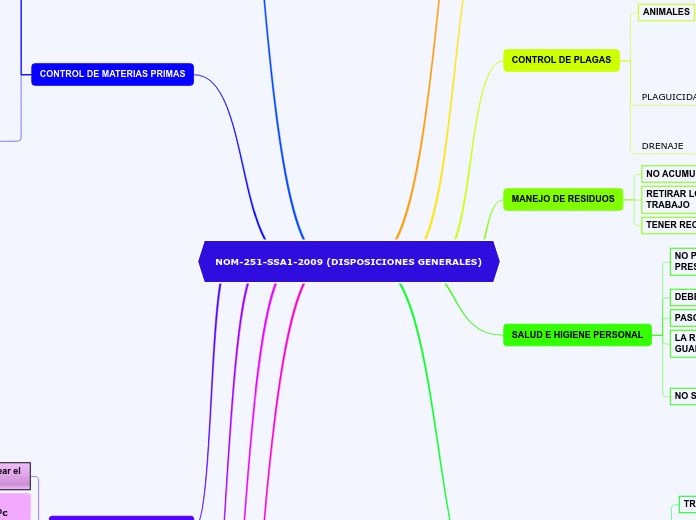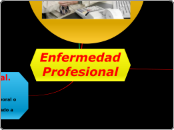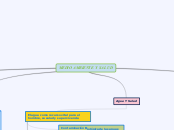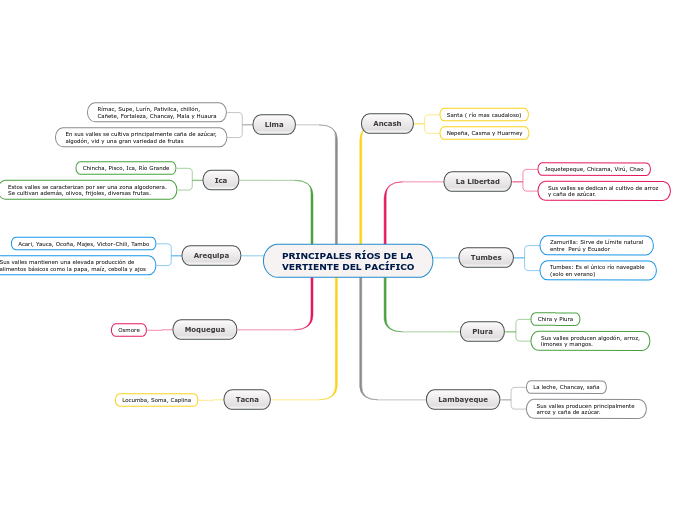NOM-251-SSA1-2009 (DISPOSICIONES GENERALES)
The part of speech is a category to which a word is assigned according to its syntactic functions. In English the main parts of speech are noun, pronoun, adjective, determiner, verb, adverb, preposition, conjunction, and interjection.
INSTALACIONES Y AREAS
CONTAR CON INSTALACIONES QUE EVITEN LA CONTAMINACION
TUBERIAS, RIELES Y CABLES
debe ester en buenas condiciones con el mantenimiento requerido
PUERTAS Y VENTANAS
para la producción debe tener protección
PAREDES
facil de limpiar sin grietas
PISOS
facil de limpiar, sin grietas,
SERVICIOS
A conjunction is a word like 'if' 'but' or 'and' which is used to connect sentences or clauses together.
debe haber agua asi como las instalaciones necesarias para su almacenamiento
Coordinating conjunctions always connect phrases, words, and clauses. They are: for, and, nor, but, or, yet, so.
aire acondicionado
si se cuenta con ello evitar goteras
ventilacion
deben evitar el calor y condensacion de vapores excesivos
baños
deben contar con separaciones fisicas completas
cisternas o tinacos
si tienen respiradero este debe tener un filtro
las paredes deben ser lisas
drenaje
para evitar plagas
canaletas o coladeras con rejillas
debe haber trampas contra olores
ALMACENAMIENTO
A preposition is one of the most exciting parts of grammar. A preposition is used to describe the location of something in relation to something else.
herramientas de limpieza
Participle preposition consists of words that end in “ing”.
deben estar colocadas en un lugar donde no contaminen a la materia prima
estiba
When a preposition consists of more than one word, it is called double preposition.
evitar rompimiento y exudación del empaque
colocacion
Compound preposition consists of two or more words.
se deben colocar donde circule el aire
materias primas
When a preposition consists of one word it is called single or simple preposition.
deben colocarse en mesas, estibas, tarimas, etc, donde evite su contaminación
deben ser adecuada al tipo de materia prima
CONTROL DE OPERACIONES
An interjection is used to express emotion in a sentence.
Think of other interjections!
los alimentos procesados no deben estar en contacto con los no procesados
se debe evitar la contaminación cruzada
los equipos de refrigeración deben tener un maximo de 7ºc
los estableciminetos pueden emplear el sistema HACCP
CONTROL DE MATERIAS PRIMAS
An adverb is used to describe a verb, but it can also describe an adjective or another adverb.
Adverbs normally help paint a fuller picture by describing how something happens.
caracteristicas para la aceptación y rechazo
PESCADO
AGALLAS SECAS Y GRIS O VERDE, TEXTURA FLACIDA Y OLOR AGRIO PUTREFACTO
AGALLAS ROJAS Y HUMEDAS TEXTURA FIRME Y OLOR CARACTERISTICO
AVES
COLOR VERDOSA, OLOR PUTREFACTO, TEXTURA BLANDA
COLOR Y OLOR CARACTERISTICO Y TEXTURA FIRME
CARNES FRESCAS
COLOR VERDOSA, TEXTURA VISCOSA Y OLOR PUTREFACTO
COLOR Y OLOR CARACTERISTICO Y TERXTURA FIRME
PRODUCTOS DE ORIGEN VEGETAL
APARIENCIA CON MOHO, OLOR PUTREFACTO
APARIENCIA FRESCA Y OLOR CARACTERISTICO
BEBIDAS EMBOTELLADAS
OXIDADAS O CON MATERIA EXTRAÑA
LIBRE DE MATERIA EXTRAÑA, TAPAS EN BUEN ESTADO
REFRIGERADAS
MAYOR DE 4ºC EXCEPTO LOS DE PESCA
PRODUCTOS CON 4ºC O MENOS EXCEPTO PRODUCTOS DE PESCA QUE PUEDEN SER 7ºC
CONGELADAS
CON SIGNOS DE DESCONGELACION
SIN SIGNOS DE DESCONGELACION
enlatadas
ABOMBADAS, ABOLLADAS,
INTEGRAS
preenvasadas
RECHAZO
rotos, con fugas o evidencia de fauna nociva
ACEPTACION
INTEGRO Y EN BUEN ESTADO
no aceptar la materia prima con envase dañado
The intensifiers strengthen adverbs adjectives and adverbs and down- toners make them weaker.
down-toners
Fairly, Rather
intensifiers
Extremely, Very
acomodar bien las materias primas
Just, Afterward, Soon, Currently
no utilizar materias primas caducadas
Always, usually, Never
TENER IDENTIFICADAS LAS MATERIAS PRIMAS
Carefully, Slowly
CONTROL DE ENVASADO
A numeral is a word or phrase that describes a numerical quantity.
Some theories of grammar use the word 'numeral' to refer to cardinal numbers that act as a determiner to specify the quantity of a noun, for example the 'two' in 'two hats'.
ASEGURAR LOS ENVASES LIMPIOS
One, two..
LOS ENVASES DEBEN ESTAR PROTEGIDOS DE POLVO
First, second..
LOS MATERIALES DE MATERIAS PRIMAS DEBEN SER INOCUOS
ENVASES CON QUIMICOS NO SE DENE UTILIZAR DE NUEVO PARA ALMACENAR
TRANSPORTE Y CAPACITACION
An article is a word used to modify a noun, which is a person, place, object, or idea. Technically, an article is an adjective, which is any word that modifies a noun.
CAPACITACION
Indefinite articles are the words 'a' and 'an.' Each of these articles is used to refer to a noun, but the noun being referred to is not a specific person, place, object, or idea. It can be any noun from a group of nouns.
PASOS PARA TENER LA CAPAPCITACION ES CONOCER Y:
CONOCIMIENTO DE LA NOM
REPERCUSION DE UN PRODUCTO CONTAMINADA
EL TIEMPO ANTES DE CONSUMIRLO
LAS CONDICIONES EN QUE SE PUEDEN RECIBIR Y ALAMCENAR
EL GRADO Y TIPO DE PRODUCCION
CONOCER LA FORMA DE PROCESAR
CONOCER LA NATURALEZA DE LOS PRODUCTOS
HIGIENE PERSONAL
CAPACITARSE EN BUENA HIGIENE
TRANSPORTE
It refers directly to a specific noun or groups of nouns.
LOS VEHICULOS DEBEN ESTAR LIMPIOS
DEBEN IR SEGUROS
CONTAMINANTES FISICOS Y QUIMICOS
DE PLAGAS
DEBEN SER TRANSPORTADOS EN CONDICIONES
SALUD E HIGIENE PERSONAL
A pronoun is a word that can be used in place of a noun, typically after the noun itself has already been stated.
NO SE PERMITE
Reciprocal pronouns are used for actions or feelings that are reciprocated. The reciprocal pronouns are each other and one another.
BEBER
FUMAR
COMER
LA ROPA Y OBJETOS PERSONALES SE GUARDAN
A reflexive pronoun ends with ...self or ...selves and refers to another noun or pronoun in the sentence (usually the subject of the sentence). The reflexive pronouns are myself, yourself, herself, himself, itself, ourselves, yourselves, and themselves.
Itself, Himself
PASOS PARA LAVARSE LAS MANOS
Demonstrative pronouns are used to demonstrate (or indicate). This, that, these, and those are all demonstrative pronouns.
This, These
DEBEN PRESENTARSE ASEADOS
Possessive pronouns are used to show possession. The possessive pronouns are mine, yours, his, hers, ours, and theirs.
His, Your
NO PUEDEN ASISTIR GENTE QUE PRESENTE
The personal pronouns are I, you, he, she, it, we, they. More often than not (but certainly not always), they replace nouns representing people.
NO PRESENTE HIGIENE ADECUADA
ENFERMEDAD
MANEJO DE RESIDUOS
A noun is defined as a person, place, thing or idea. Proper nouns always begin with a capital letter. Common nouns, which are general words, such as 'cars,' are not capitalized.
TENER RECIPIENTES IDENTIFICADOS
A noun which refers to a group of things/people.
Family, Class
RETIRAR LOS RESIDUOS DEL AREA DE TRABAJO
Countable nouns are nouns that can be counted, even if the number might be extraordinarily high.
Uncountable nouns are nouns that come in a state or quantity which is impossible to count; liquids are uncountable, as are things which act
like liquids.
Cats, Rain
NO ACUMULACION DE RESIDUOS
Proper nouns are the names of specific people or places. They should always begin with a capital letter.
Create sentences
Mary, Paris
CONTROL DE PLAGAS
A verb is an action word or 'doing' word that signifies movement in some way.
DRENAJE
TENER CUBIERTA APROPIADA PARA EVITAR PLAGAS
PLAGUICIDAS
DBEN ESTAR AISLADOS CON PERMISO RESTRINGIDO
DEBER TENER AUTORIZACION
ANIMALES
A verb with its own meaning: a verb that is not an auxiliary verb.
EVITAR CONDICIONES PARA QUE SE GENEREN PLAGAS
MEDIDAS PARA PREVENIR INFESTIONES
NO SE PERMITEN ANIMALES DOMESTICOS
MANTENIMINETO Y LIMPIEZA
EL EQUIPO
LIMPIARSE SEGUN LA NECESIDAD
LOS AGENTES DE LIIMPIEZA Y DESINFECCION
DEBEN UTILIZARSE CONFORME AL MANUAL
LOS BAÑOS
DEBEN ESTAR LIMPIOS Y DESINFECTADOS
SI SE EMPLEAN LUBRICANTES
DEBEN SER DE GRADO ALIMENTICIO
DEBEN ESTRA EN BUENAS CONDICONES
CONTROL DEL AGUA EN CONTACTO CON LOS ALIMENTOS
SI SE UTILIZA VAPOR
NO DEBE CONTENER GASES NOCIVOS
EL AGUA UTILIZADA EN DEBE CUMPLIR CON LOS LIMITES DE CLORO ESTABLECIDO AL TENER CONTACTO CON:
MATERIA PRIMAS
ENVASES
ALIMENTOS









